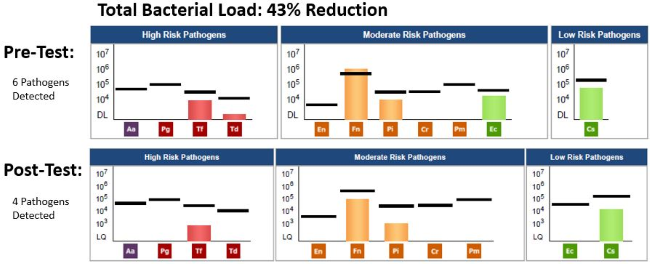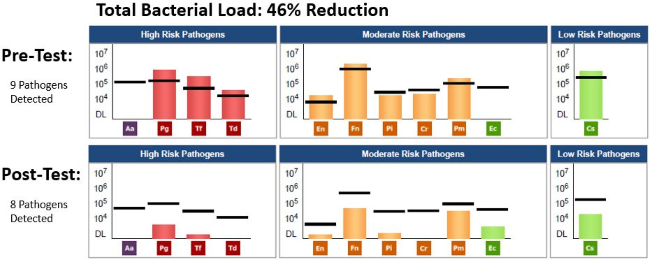Pregnancy
![Thumbnail [200x250]](img/case-study/gabby_finn/finn_main.jpeg)
Pregnancy & Periodontal Inflammation: Pathogens or Hormones?
The Challenge:
Pregnant, periodontal maintenance patient appointed with increasing periodontal measurements over the last two periodontal maintenance appointments. The goal of testing is to establish the cause for the increase of inflammation.
The Background:
- Age: 44
- Sex: F
- Medical History: Patient is 4 months pregnant with a history of smoking.
- Last Dental Exam: Initial therapy was completed in 2013. The most previous periodontal therapy was completed in 2018. Both therapies consisted of LANAP.
- Home Care: 2-3x day with electric toothbrushing, flossing 1x pm and Waterpik™ 2x/day
- Chief Complaint: Patient has noticed pus around crowns in morning.
- Periodontal Assessment: 4mm-9mm pocketing present with bleeding upon probing, tissue appears to be inflamed, red and bulbous.
The Solution:
- Date of Pre MyPerioPath® test: 8/13/2021
- Periodontal Therapy: Adjusted periodontal maintenance appointments to every month until delivery. This allowed for closer monitoring and placement of Arestin when needed.
- Systemic Antibiotic Used: This wasn’t considered however, the localized antimicrobial, Arestin® will be placed as needed.
- Home Care: Stressed continued home care, no modifications are needed.
- Retesting will occur following the delivery.
The Result:
Periodontal health during pregnancy can be extremely difficult to achieve. There are many systemic conditions such as immunosuppressive hormones and stress, in addition to potential localized triggers such as periodontal pathogens. To know exactly how to approach care, testing was a must and revealed significant pathogens, some of which could complicate a pregnancy.

About the Author:

Gabby graduated from Madison College in 2018. What she enjoys most about dental hygiene is connecting with patients and educating as well as motivating them to have perfect home care instructions to allow for not only a healthy mouth, but overall health as well. Working at Barotz Dental has allowed her to be a part of life changing cases from start to finish. She is empowered as the hygienist to be a leader in the hygiene department. Gabby is a proud mother of a bunny named Foo and a kitten named Indy. In her free time, she loves doing anything outside, going to parks in the city, hiking in the mountains, and camping with friends.
![Thumbnail [200x250]](img/case-study/Pregnancy%20&%20Pathogens%20Dela%20Paz%20Case%20Study_269365972.jpeg)
Periodontal Disease & Pregnancy
The Challenge:
The patient is expressing oral inflammation and is pregnant. The clinical signs of periodontal disease due to pathogenic bacteria look identical to the clinical signs produced by pregnancy hormones.
The Background:
- Age: 34
- Sex: Female
- Medical History: 21 weeks pregnant, no history of tobacco use
- Home Care: Brushing 2 x day and occasional flossing
- Clinical Assessment: Moderate bleeding on probing
- Periodontal Assessment: Generalized 3-4 mm probe depths with marginal inflammation
Additional Comments: Increase recall during pregnancy
The Solution:
- Date of Pre MyPerioPath®: 6/14/2018
- Periodontal Therapy: Sub & supra debridement, irrigation with chlorhexidine & periodontal laser (SiroLaser) on 6/14/2018
- Systemic Antibiotic Use: Metronidazole 500 mg bid for 8-10 days was prescribed on 6/19/2018 due to evidence that Fn can complicate pregnancies. However, the patient never started or completed the course.
- Home Care Instruction: Increase brushing & flossing instruction
- Date of MyPerioProgress® (post-therapy test): 10/31/2018
The Result:
The patient, still pregnant, returned on 9/26/2018 for adult prophylaxis. The clinical improvements included generalized knife-edge margins with localized light bleeding on scaling. The patient reported that she had started to floss daily and brush 2 x day. When asked about taking the systemic antibiotic, the patient stated that she did not take the Metronidazole as she was apprehensive due to pregnancy.
A post MyPerioPath®, aka MyPerioProgress®, was collected post-partum 10/31/2018. The results revealed a dramatic reduction of pathogen load by 43% with Td below the limit of quantification, Tf reduced by 1 log, and Fn reduced by 2 logs. It was decided to wait and secure the specimen post-partum because I wanted to see the change in pathogen load after delivery.

About the Author:

Carmeliza dela Paz received her undergraduate degree with a Bachelor of Science from Regis College in 1991 and completed her doctorate in dental sciences at University of Colorado Health Science Center in 1998. In her spare time, she enjoys reading especially international and domestic news tinkering around, and playing fantasy football. Her favorite football team is the Denver Broncos. Dr. dela Paz will help you understand the Mouth-Body Connection and how to bring you to a healthier and happier smile.
![Thumbnail [200x250]](img/case-study/LIGHT%20Pathogens%20and%20Pregnancy%20Case%20Study_18283.jpg)
Pathogens & Pregnancy
The Challenge:
Our goal was to treat the periodontal disease and reduce bacterial levels to lessen the impact of her periodontal disease to her potential pregnancy.
The Background:
- Age: 31
- Sex: Female
- Medical History: Patient revealed her family was ready to start to try to become pregnant.
- Last Dental Exam: 6 months ago
- Chief Complaint: “My gums are swollen and painful.”
- Periodontal Assessment: Radiographic evidence of horizontal bone loss, heavy generalized subgingival calculus present. Tissue: red and erythematous. Periodontal pockets depths ranged between 5-9 mm. Diagnosed chronic severe periodontal disease.
The Solution:
- Date of Pre MyPerioPath® (pre-therapy test): 3/22/2017
- Periodontal therapy: 4 quads of scaling & root planing, irrigation with chlorhexidine and laser decontamination
- Systemic Antibiotic Used: Recommendation per results
- Date of MyPerioProgress® (post-therapy test): 6/27/2017
Additional comments: The MyPerioPath revealed significant levels Fusobacterium nucleatum. This particular bacteria is associated with low birth weights and stillborn babies. (1,2)
The Result:
The patient returned 3 months later for her first periodontal maintenance visit after scaling and root planing. Results from the initial saliva test showed 9 bacterial pathogens present with 7 pathogens above reference lines, including Fn bacteria associated with low birth weight and still born babies.(1, 2) After therapy and antibacterial services, a follow-up MyPerioPath (MyPerioProgress) was performed to reveal the above reference line pathogens decreased from 7 to 0. The importance of this case and our protocol is that we were able to tell the patient with confidence that her periodontal disease was controlled, and her current bacterial pathogens would not affect her pregnancy. This is an important test to do for any patient planning to become pregnant.

About the Author:

References:
- Han YW, Houcken W, Loos BG, Schenkein HA, Tezal M. Periodontal disease, atherosclerosis, adverse pregnancy outcomes, and head-and-neck cancer. Adv DentRes 2014;26:47-55.
- Andonova I, Iliev V, Zivkovic N, Susic E, Bego I, Kotevska V. Can oral anaerobic bacteria cause adverse pregnancy outcomes? Pril (Makedon Akad Nauk Umet Odd Med Nauki) 2015;36:137-43.